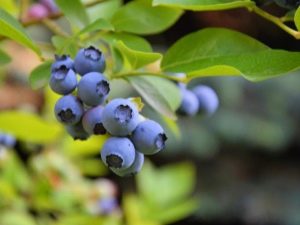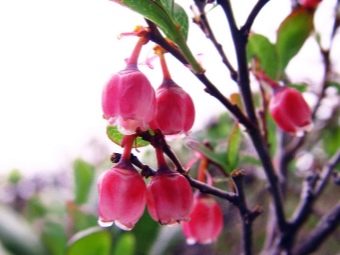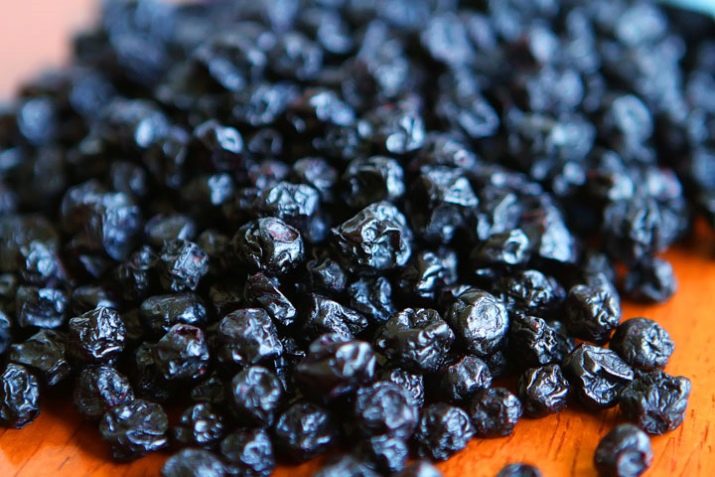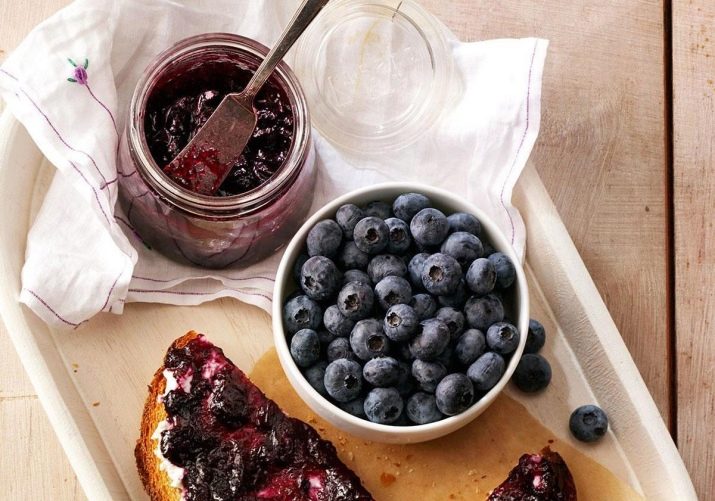Blueberries: benefits, berry picking and application

Everyone at least once in his life has heard that there is a berry called blueberries. But most people don’t know anything about it, never tasted it, and they don’t have a clue how it looks and where to collect it. Let's try to figure out what kind of berry, what useful properties it has, where it grows, how to use it and where to use it.
What kind of berry?
Blueberry is an undersized wild-growing shrub, photophilous and frost-resistant. The plant germinates very slowly, the age of the bush can reach 100 years, but it begins to bear fruit after 10-15 years. It blooms in late May or early June, but the berries ripen by August. Fruits of a blueberry have a thin gentle cover of blue color, from above covered with a bluish raid. In case of inaccurate gathering berries can be damaged. The flesh of the berries is tender and has a sweetish taste.
Fresh blueberries can be stored for up to 3 weeks at a temperature of 0 to 5 degrees, but in the frozen state, the shelf life is a whole year.
Very often, next to the blueberry bush can be found companion plants: blueberries and lingonberries.
The description of the blueberry will be incomplete without mentioning the characteristic range of growth - the tundra, forest-tundra, alpine, mountain forest belt of the Northern Hemisphere.
Beneficial features
Blueberries contain a number of useful components. thanks to which this berry has many healing properties:
- high content of vitamin C increases the weakened immunity, reduces inflammation in the body, kills pathogens and bacteria;
- Vitamins A and E provide a berry with an antioxidant effect that helps remove harmful substances from the body;
- B vitamins increase the body's immune ability, improve metabolic processes;
- pectin helps to remove dangerous radioactive elements from the body;
- the chemical composition of the berries has a positive effect on the cardiovascular system, improving blood circulation, the digestive system, increasing secretory activity, and the thyroid glands, restoring hormonal balance;
- due to the mineral composition (magnesium, iron, sodium, calcium, phosphorus, potassium, silver) all metabolic processes are restored and the body is enriched with microelements that do not come from everyday food;
- organic acids add antiseptic and antibacterial action to the berry.
Where is growing?
In the wild, blueberries grow in the Northern Hemisphere, in nature - far from large cities. Usually, The main area of distribution of blueberries on the map is located where most people only dream of visiting - in terms of untouched nature, namely:
- in Russia it grows predominantly in the forests of Siberia, the tundra, in the Far East, in the upper belt of the mountains and marshes of the Urals, in remote Novosibirsk, and also in the Leningrad, Arkhangelsk and Vologda regions;
- in North America, blueberry bush grows in the expanses from Alaska to California;
- In addition to the mainland of Eurasia, blueberries are grown on the Japanese and British Isles, in Iceland, on the Iberian Peninsula, and even in North Africa.
In the cultivated form, blueberries can be found anywhere in the world, be it Sochi, Krasnodar Territory, Rostov Region, Ukraine, the southern part of Asia or even the highlands of Peru.
It is in the northern regions for the natural cultivation of blueberries optimal conditions are created:
- temperate or cold climate;
- wet places;
- swampy soil with a high content of coniferous humus.
Planting and care
Remember several features of planting and caring for blueberries.
- If you dig up a bush in the forest and plant it in your country house, then it is unlikely that it will survive - wild blueberries take root very poorly after transplanting. For her, it is very important to preserve natural climatic conditions.
- For garden conditions, it is best to acquire cultivated varieties of blueberries, which are adapted to artificially created conditions.
- Consider blueberry compatibility with other plants.
- Watering shrubs can be done with a weak vinegar solution, as blueberries like acidic soils.
- It is better to plant a bush in the spring or in the fall, in in advance prepared soil.
- Blueberries love airy soil, which is why you should not be tamped with it.
- Land moistening should occur regularly.
Application and contraindications
Apply blueberries in the following areas: pharmaceuticals, medicine, cosmetology, cooking.
Pharmaceuticals use the properties of the components that make up the blueberry for the production of medicines. In medicine, blueberry has a wide range of applications - it is recommended for a number of ailments:
- pancreas - pancreatitis, diabetes;
- cardiovascular system - atherosclerosis, hypertension;
- joints - arthritis;
- digestive tract - gastritis, colitis, constipation, cholecystitis;
- urinary system - nephritis, cystitis;
- nervous system - Alzheimer's disease, neurosis, depression;
- for the prevention of cancer.
In cosmetology, blueberries are a very popular remedy for aging and inflammation of the skin. Berries prepare anti-aging face masks, toning lotions, nourishing creams.
In cooking, these small blue berries are not only a decoration of various dishes, but also a delicate dessert. Blueberries are also added to the staining dish, as its juice gives a purple hue. The fruits are stored in different ways: frozen, canned, soaked, sugar.
But unfortunately, each product has its own contraindications, and blueberries also can not be eaten in some cases.
- Allergic reaction. The percentage of people with intolerance to blueberry components is very small, but this point must be taken into account.
- When excessive consumption of berries in the body accumulates antioxidants, which in large quantities have a negative effect. Over-saturation with blueberry components can cause poisoning.
- In diseases such as thrombophlebitis or thrombosis, you should not abuse the berries, because they increase blood clotting.
- Relative contraindication - pregnancy and lactation. When dosed, blueberries will not harm mother and baby, but only enrich both bodies with useful substances. But with excessive use may be the opposite situation, which will harm both.
Recipes
Decoction
It will take 1 cup of fresh or frozen berries, which need to be poured over with 2 glasses of water and left to simmer until boiling. After that, the drink must be removed from the stove and let it brew. The decoction can be used for chronic constipation, hypertension, pancreatitis and obesity. Dosage - 4 tbsp. l 3-4 times a day.
Honey or sugar can be added to taste, and in diabetes mellitus, cowberry leaves are used instead of berries, using the same principle and in the same proportions.
Infusion
To prepare the infusion, half a cup of blueberry berries must be ground to a puree state. Then pour boiling water over the mashed potatoes and set aside the container for 1 hour, so that the drink will infuse and cool. This recipe can be used for diseases of the blood, liver, heart. Drink a drink you need during the day, half an hour after a meal.
Mashed with sugar
It is necessary to crush 1 kg of berries in a mortar, and then pour 4 cups of sugar. Next, you need to heat the mixture so that sugar will dissolve, but you can not bring it to a boil. In this state, the mass should be poured into sterilized jars and rolled, using with reduced immunity, for the prevention of parasites and other diseases. This recipe is used with the preventive purpose on 1 tsp. 4 times a day, you can add to warm tea.
The advantage of this recipe is that the healthy berries remain fresh and absolutely do not lose their beneficial properties. But it is not recommended to use sweet blueberries for diabetics, people with obesity and pancreatitis.
In dried form
In order for berries to be stored at home for a long time, it is best to dry the blueberries. To do this, you need to spread the fruit on a baking sheet and dry in the oven for 5-6 hours at a temperature of up to 60 degrees. Dried berry can be used for both therapeutic and prophylactic purposes, as well as in culinary recipes.
Jelly
For this delicacy you need 300 g of blueberries, 140 g of sugar and 30 g of gelatin. All ingredients are mixed so as to form a slurry, to which you need to add 1 liter of water. Bring the resulting mixture to a boil to dissolve sugar and gelatin. Fill in molds and leave in the refrigerator for 40 minutes, after which the jelly is ready to eat.
Rejuvenating mask
The main ingredient is fresh berries that need to be crushed. This mass is applied to the face for 15 minutes, and then washed off. You can add fat sour cream - so the mask will become more nutritious.
On how to collect and store the berry, as well as the benefits of blueberries, see the following video.










































